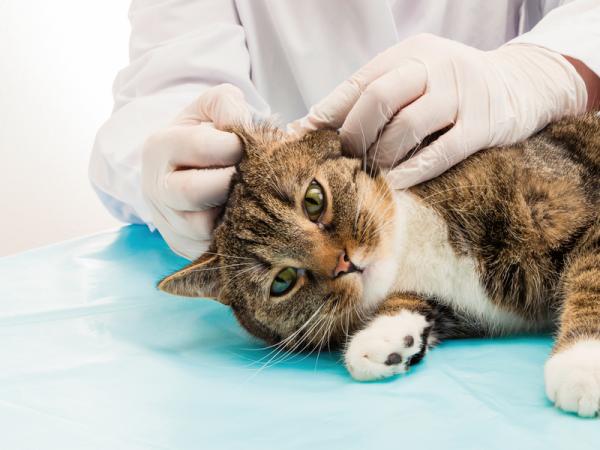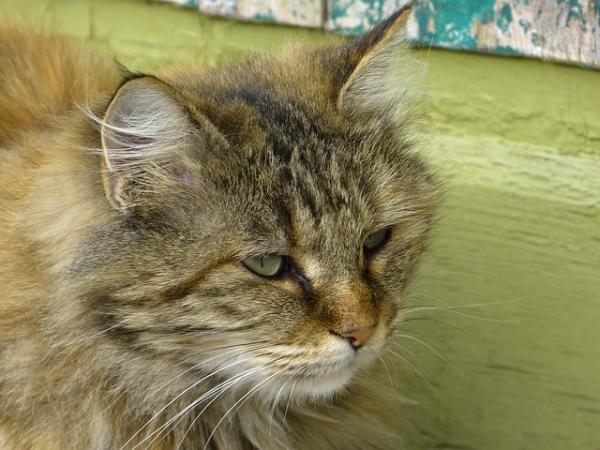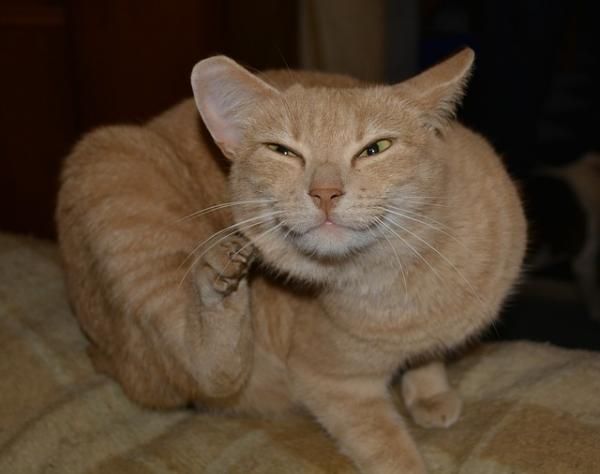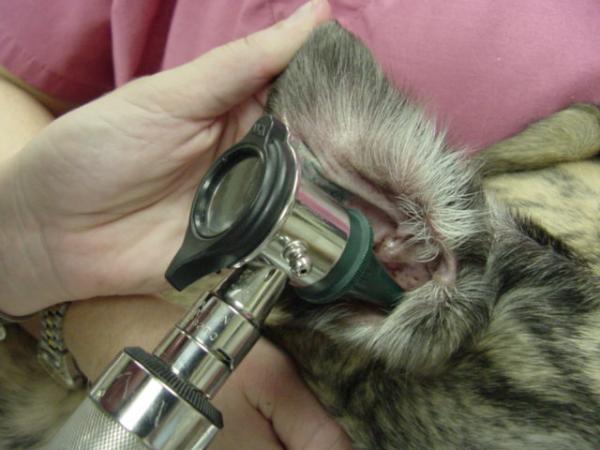Otitis in cats

Do you think that your cat possibly has otitis? Do you know how otitis may have occurred in the ears of your faithful companion? What are the symptoms, how is it treated and what consequences can it bring?
If you want to know about everything related to otitis in cats, read this article carefully and help your pet recover its health.
What is otitis?
Otitis is the inflammation of the epithelium that covers the auditory canal and the auricular pavilion. This inflammation usually causes pain and temporary hearing loss among other things. In addition, it is accompanied by many other symptoms that make it more easily identifiable and will be explained later.
This problem otic tends to be a lot when felines are with low defenses for some reason. It is proven that the seasons of the year in which otitis occurs most are spring and summer due to the increase in temperature and humidity in the environment. The contagion of some possible responsible for otitis such as ear mites, is given by direct contact with an area or animal infested. In shelters, in hatcheries, in areas where there are colonies of controlled cats and in general in any area where a large number of cats live together, this contagion is very frequent by direct contact, since the constant control of all and In all aspects of your health it is always very difficult. Otitis can occur without having contagion, that is, it occurs secondary form to a traumatism or a bacterial or fungal infection due to a foreign body, the more causes.
There are several types of otitis according to their cause and the area of the ear that affects. According to the affected area we can classify it in:
- Otitis externa: It is the most common otitis, but it is the least serious and the easiest to treat. It affects the external ear, that is, the ear canal from the ear pinna to the eardrum. If this otitis is very severe, the ear pinna is severely affected and the eardrum may rupture and the inflammation and affection may spread to the middle ear, causing secondary otitis media.
- Otitis media: This otitis usually occurs more commonly when an otitis externa has been treated ineffectively. It occurs in the middle ear area, where we find the eardrum that has been inflamed and even broken due to otitis.
- Internal otitis: It is the inflammation of the inner ear and usually occurs due to trauma or due to poorly healed otitis media or external. Due to its depth in the ear it is the most complex otitis to heal.

Is there a predisposition in some type of cat?
First, to say that, generally, there is less predisposition in cats than in dogs. But, in fact any individual can suffer otitis and inside the domestic felines we find that those that have greater predisposition are those that have between one and two years.
In addition, copies of long hair, As they usually have enough hair on their ears, they also have a better chance of getting otitis since the hairs in the ears retain more dirt and moisture. The felines that are a lot of time outdoors They are more at risk of suffering from atrial diseases, including otitis, so it is very important to periodically check their ear canals. They are also very prone to this ear problem, but secondarily, the individuals presenting the very low defenses for some other main problem.

What are the causes of otitis?
Otitis can be caused by various things such as foreign bodies lodged in the auditory canal, bacteria, fungi (yeast), external parasites such as mites and traumatisms in the area.
Here we explain a few causes of this otic disease:
- Ectoparasites: The ectoparasites that produce the most frequent otitis in felines are mites, microscopic external parasites, but when they occur in large numbers in an area they can be seen directly. This mite is called Otodectes cynotis and not only is it lodged in the ear when it infests an animal, but it is also found on the skin of the head and neck.
- Bacteria and fungi (yeast): These are opportunistic pathogenic microorganisms that cause secondary otitis. They take advantage of situations such as excessive humidity, residual water after a bath that may have remained in the ear, the presence of foreign bodies, trauma, allergies and irritations produced by cleaning products for the ears that are unsuitable for cats. The most common bacteria are Pasteurella multocida, Pseudomonas aeruginosa, Proteus and E. coli. In the case of fungi the most common is Malassezia.
- Strange bodies: Sometimes, especially in the case of cats that are much outside, can enter the ear canal objects such as leaves, twigs and spikes that become a foreign body housed in the ear of our cat. This object lodged in the ear canal will greatly annoy the animal that will try to remove it, generally without success, and finally end up damaging and inflaming the ear and producing secondary otitis by bacteria or by opportunistic fungi. We must avoid extracting the foreign body ourselves and allowing a veterinarian to do so with adequate material. In cats this case of otitis is less frequent than in dogs.
- Trauma: As we have mentioned before, another reason that can cause secondary otitis in the ears of our companions are the traumatisms, that is to say, some blow that has produced damages internally and from this inflammation and wounds take advantage of bacteria and fungi and cause an otitis.
Other diseases and problems that give rise to secondary otitis: Secondary otitis tends to occur more commonly due to the above mentioned, but it can also be derived from other diseases that the feline already suffers and therefore be a symptom of these. For example:
- Hereditary problem of keratization: It is a defect in the queratización that occurs in a hereditary way. This problem in the process of keratization causes inflammation and seborrhea and easily leads to secondary erythematous and ceruminous otitis. If complicated, it can lead to secondary purulent otitis. This case of hereditary disease usually occurs more frequently in Persian cats.
- Atopy and food allergy: This type of allergy is more common in dogs but is also seen in domestic cats. They can produce secondary otitis, especially when these allergic processes have previously produced facial dermatoses. In this case, opportunistic organisms are usually several types of bacteria, but especially the yeast (fungus) called Malassezia pachydermis.
- Contact hypersensitivity and irritant reaction: Cats in general are very sensitive to products and medicines, but especially to ear cleaning products such as ear drops. These products often cause severe irritation in the ear canal giving way to secondary otitis. We should never use these products that are not indicated for use in cats and preferably we will use one recommended by our veterinarian.
- Immune diseases: This type of diseases are associated with atrial lesions and otitis externa. Due to the excessively low defenses that these diseases cause in our pets, bacteria and fungi find the opportunity to proliferate and secondary external otitis are easily reported. We must keep in mind the FIV or feline immunodeficiency virus.
- Tumors: There are cases in older cats that otitis is recurrent and even chronic, so we should suspect a tumor, either benign or malignant, in the structures attached to the ear. For example, squamous cell carcinomas in white ears are common.
- Nasopharyngeal polyps: They are non-neoplastic proliferations, that is, they are not abnormal. Therefore, it is common for young cats to detect these polyps in the areas of the middle ear, ear canal and nasopharyngeal mucosa. Along with foreign bodies, these polyps are the most common cause of unilateral external otitis in cats. In this case, otitis is usually resistant to medication and may cause otitis media with respiratory signs.
- More diseases and problems that can cause otitis: Scabies, seborrheic disorders, metabolic, endocrine and nutritional diseases.

What symptoms does otitis show in cats?
The signs and symptoms that our feline will present in case of otitis will depend and vary, especially in the degree of intensity of these, of the origin causing otitis. The symptoms that we will recognize are:
- Frequent shaking of the head
- Inclination of the head. If it occurs only to one side, this indicates unilateral otitis that is usually produced by the presence of a foreign body in that ear. In case of annoying the two ears will alternate the side as they bother more one or the other.
- Pain in the area when we caress them. They often complain and meow a lot and even scream because of the pain.
- Itching that can go from moderate to severe.
- Due to the itching they scratch and rub their ears and neck very frequently until they get to produce wounds in the area.
- Ears reddened and swollen area.
- Irritation, exudation and pyoderma of the entire affected area.
- Bad humor and even aggressiveness, no desire to play and it may happen that they stop eating due to the great discomfort and pain they may be having.
- Abundant dark cerumen in the ears.
- Hearing loss.
- Bad smell in the ears.
- Loss of hair in areas affected by excessive scratching caused by itching.
- Presence of mites in the ears. In case of presenting a very severe mite infestation, it should be taken into account that it may be a case of defenses that are too low due to FIV (feline immunodeficiency virus).
- Otohematoma: Problem derived from excessive scratching and continuous agitation of the head. The otohematomas are a collection of blood in the auricle and appear on the concave surface of the ear, between the cartilage and the skin or inside the cartilage, when the blood capillaries break. Externally it is observed as a ball in the ear, which annoys the animal very much and is very hot. The only solution is surgery.
It is of vital importance for the result of the health of our partner that we immediately detect one of these symptoms let’s go to our veterinarian trusted to review and advise us.

How can we prevent and treat it?
Here are some tips and remedies to prevent and treat otitis in cats:
- Keep track of your health from home: It is vital that periodically whenever we brush and bathe our pets we look at the state of various areas of their body including the ears. If we detect any symptoms of those previously described we should not hesitate to go to the veterinarian as soon as possible and thus avoid aches, pains and complications to our friends.
- Avoid getting dirty ears: When grooming our cats we should look at the dirt that may have in the ears. If you see that you need to clean some accumulated cerumen, usually every two or three weeks, we will never use cotton buds that we usually use. We should think that with a stick, we can do a lot of damage to the inner ear in case of sudden movement, even break the eardrum. Therefore, the best way to clean the ear is with a sterile gauze wrapped in our finger and wet with saline and gently remove the dirt only from the area of the auricle, that is, only the dirt of the area that we see and not deepen.
There are ear drops or cleansers, but because felines are very sensitive to medications and products in general, whether they are chemical or natural, we must use one that has been expressly prescribed by our trusted veterinarian and never one that we see in the store. animals and we look good. Above all, we should never use a product for dogs that is not expressly indicated for cats, since this type of substances that produce irritations are also an important cause of otitis in our cats. In addition, in case of being long-haired specimens, we can ask the veterinarian to cut the hair of the ears from time to time to prevent the accumulation of dirt.
- Prevent the ears from getting wet: When we bathe them we should avoid water and soap. A simple way is, with cotton balls smeared in a little petroleum jelly, plug the ears gently so that we can then remove them easily. It is very important to remember to remove these plugs because if we leave them there they will bother our pet, but also if they can not get them out by themselves, they will turn out to be a foreign body lodged in the ear and may end up producing otitis. To remove any residue of Vaseline, cotton or if there is water, we will use a sterile gauze wrapped in a finger to remove and dry. It is very important not to enter abundant water or pressure to avoid rupture of the eardrum, but if the ear gets wet equally we must make sure that we leave it dry and clean.
- Periodic veterinary review: Each time the veterinarian visits you, either by routine or by something more specific, you should check the state of your ears more exhaustively than we can do from home. In this way we will avoid that if an otitis occurs we take too long to notice and the consequences are more serious.
- Follow The treatment indicated by the veterinarian: In case of suffering otitis, the veterinarian will offer us a treatment to follow which will be very important to do conscientiously and even if it seems that the problem has been solved we must continue until the end of the treatment. The treatment will depend on the type of otitis we face, but mainly it will be:
- First remove the foreign body if there is one.
- Perform a cleaning and drying of the ear.
- Make sure what is the cause to apply the appropriate treatment:
- Strange body: The veterinarian must remove the foreign body to perform the cures of otitis. Once the foreign body has been removed, we will perform the cures with the otic and topical medications that our veterinarian has given us and we will apply them as you have explained.
- Bacteria: It should be cleaned with water or saline so that the specialist can better review the entire auditory canal. In the case of bacterial otitis, it will prescribe a topical and otic antibacterial product.
- Mushrooms (yeasts): In this case, once the specialist veterinarian has been able to determine that the fungi are the cause, he will prescribe the appropriate fungicide product.
- Ectoparasites: Mites are the ectoparasites that cause the most common otitis. The veterinarian will prescribe an antiparasitic as a pipette to distribute in the area of the animal’s cross and an acaricidal ear product. Anti-inflammatories to reduce inflammation and pain caused by otitis.
In case that all the above does not take effect or from the beginning the veterinarian considers that it is the only solution, surgical treatment will be carried out.
We should know that when ear drops of any kind are applied to an animal in the ear, it will then shake the head to expel them from the inside of your ear as it is annoying. But it is very important to continue with the treatment and let them shake the head to more easily expel the dirt. Also, even if the otitis seems to have healed, we must finish the treatment as the specialist tells us and make it last as long as he tells us. It is very important to extend one more week, since apparently otitis is cured, to make sure that the otitis does not reappear easily.
- The Elizabethan collar: Surely, the veterinarian will offer us, as support of the treatment, an Elizabethan collar to place our pet, this necklace may seem like a nuisance to them but we should let them get used to it and wear it since it will keep them from scratching so uncontrolled and more wounds are made and even the undesirable otohematomas.

This article is merely informative, in .com we do not have the faculty to prescribe veterinary treatments or make any kind of diagnosis. We invite you to take your pet to the veterinarian in case of any type of condition or discomfort.
If you want to read more articles similar to Otitis in cats, we recommend that you enter in our section of Other health problems.


